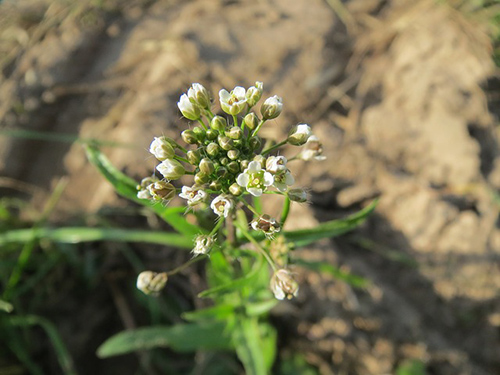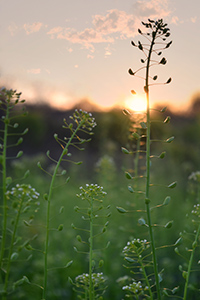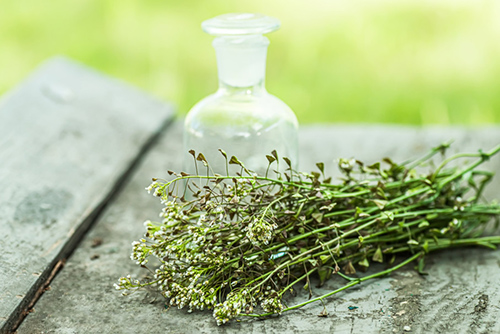Contents
The fruits of shepherd’s purse resemble the purses of shepherds in ancient times, which has given the plant its name. Honoring what its name represents—a purse with which one travels—this plant is one of the most widely known. It is found along the coast and at 2000 meters high in the mountains, in cold climates of central and northern Europe, and tropical areas of the Americas and Asia.
Although it is regarded as a native of the Mediterranean countries, its seeds’ ability to travel and adapt to any soil has made it one of the most widespread plants in the world.

Shepherd’s Purse Scientific Facts
- Other names – Cocowort, pick-pocket, St. James weed, shepherd’s heart, toywort.
- Scientific name – Capsella bursa-pastoris L.
- French – Bourse a pasteur.
- Spanish – Bolsa de pastor.
- Environment—Although it is Spread worldwide, it is more common on farmed lands (it is regarded as a weed), roadsides, and along old walls.
- Description—This annual plant of the Cruciferae family grows up to 50 cm high. Its leaves grow as a rose near the soil, with small, white flowers. The fruit is triangle-shaped, flat, and slightly salty.
- Parts of the plant used medicinally – The whole plant.
Healing Properties

The whole plant contains biogenic amines (choline, acetylcholine, and tyramine, among others), which act on the autonomic nervous system, producing contraction of arterioles, the uterus, the intestine, and other hollow organs. Its properties are the following:
- Hemostatic – (Stops hemorrhages). The substances this plant contains contract small bleeding arteries. Moreover, shepherd’s purse is rich in flavonoids of the diosmin type (an active component of several pharmaceutical preparations), increasing the capillary walls’ endurance and promoting returning venous blood flow.
- Oxytocic – It contracts the uterus and collapses blood vessels, causing bleeding in its interior.
- Digestive tract invigorating – Shepherd’s purse caused the intestines to recover their muscular tone and peristaltic contractions (which make the intestinal bolus progress inside the intestine).
Because of these interesting therapeutic properties, shepherd’s purse is a valued plant, useful for diverse diseases, as we note here:
- Uterine hemorrhages (metrorrhagia) – This is a crucial application since it stops both too-abundant menstruation in some teenagers, which appears soon after their first menstruation (menarche), and uterine bleeding, which sometimes occurs in menopause. That is to say, shepherd’s purse is suitable for both mother and daughter. However, we have to remark that it is necessary to undergo a gynecological examination to be sure that the causes of these disorders do not include tumors, anatomic alterations, or other uterine causes of bleeding.
- Epistaxis (nose bleeding)—In this case, it can be locally applied in addition to taking an infusion of this plant for some days. The method uses a noseplug soaked in the infusion to put into the bleeding nostril. It can also be applied to skin wounds and bleeding sores.
- Labor acceleration for uterine atony or weakness. Its action resembles ergotamine, an alkaloid extracted from rye ergot, but with fewer side effects.
- Intestinal atony – Shepherd’s purse is helpful to combat intestinal atony produced during convalescence from fever or infectious disease and for the frequent cases of constipation caused by intestinal laziness.
- Low blood pressure – It is recommended for those suffering from low and skinny women.
This herb is a fantastic blood coagulant inhibiting external or internal bleeding. It is an excellent internal astringent that can stop bleeding from the bladder, kidneys, colon, and lungs. For this purpose, fresh plant tops are best used, and an infusion of dried herbs can also be employed. It is also helpful in treating bedwetting and excessive menstrual bleeding. Because of its ability to constrict blood vessels, it will increase blood pressure. However, it can also regulate heart action and blood pressure, whether too high or low.
Shepherd’s purse is also suitable for hemorrhoids and intermittent fevers and is specifically good for halting diarrhea. It can improve intestinal and bowel action and promote uterine contracts during childbirth. Steep one teaspoon fresh or two teaspoons dried herb in ½ cup water and take one cup daily, unsweetened, a mouthful at a time.
Externally, place the juice inside an ear to stop earaches. This remedy can also halt strange noises in the ear. The plant is also used in poultices and washes for wounds on the body, primarily the head. It can also inhibit surface bleeding.
NOTE: Abstain from storing this herb for more than one year.

Warning
This plant’s small amount of tyramine and other biogenic amines causes a mild vasoconstrictor and hypertensive effect. People suffering from arterial hypertension (high blood pressure) must control blood pressure every day to be treated with this plant.
How to use Shepherd’s Purse
- Infusion with 30 to 60 grams of plant per liter of water, steeping for 10 minutes. Drink from three to five cups daily, not at mealtime. In the cases of menstrual disorders, this infusion must be first taken a week before the day menstruation is expected to occur.
- Compresses soaked in the same infusion used internally.
- Gauze packing, soaked in the infusion mentioned above, especially for nose bleeds.
Tincture: Twenty to sixty drops one to two times daily. Fluid Extract: ¼ to ½ teaspoons one to two times daily. Powder: Two to ten #0 capsules (15 to 60 grains) once or twice daily.
DISCLAIMER: All content on this website is presented solely for educational and informational objectives. Do not rely on the information provided as a replacement for advice, diagnosis, or treatment from a qualified medical expert. If you are pregnant, nursing, or have any preexisting medical concerns, talk to your doctor before using any herbal or natural medicines.
REFERENCES
- George D. Pamplona-Roger, M.D. “Encyclopedia of Medicinal Plants.” George D. Pamplona-Roger, M.D. Encyclopedia of Medicinal Plants. Ed. Francesc X. Gelabert. vols. 2 San Fernando de Henares: Editorial Safeliz, 2000. 628, 629. Print.
- Vance Ferrell Harold M. Cherne, M.D. The Natural Remedies Encyclopedia [Book]. – Altamont, TN: Harvestime Books, 2010. – Vol. Seventh Edition: 7: pp. 179.
- WebMD: https://www.webmd.com/vitamins/ai/ingredientmono-51/shepherds-purse
